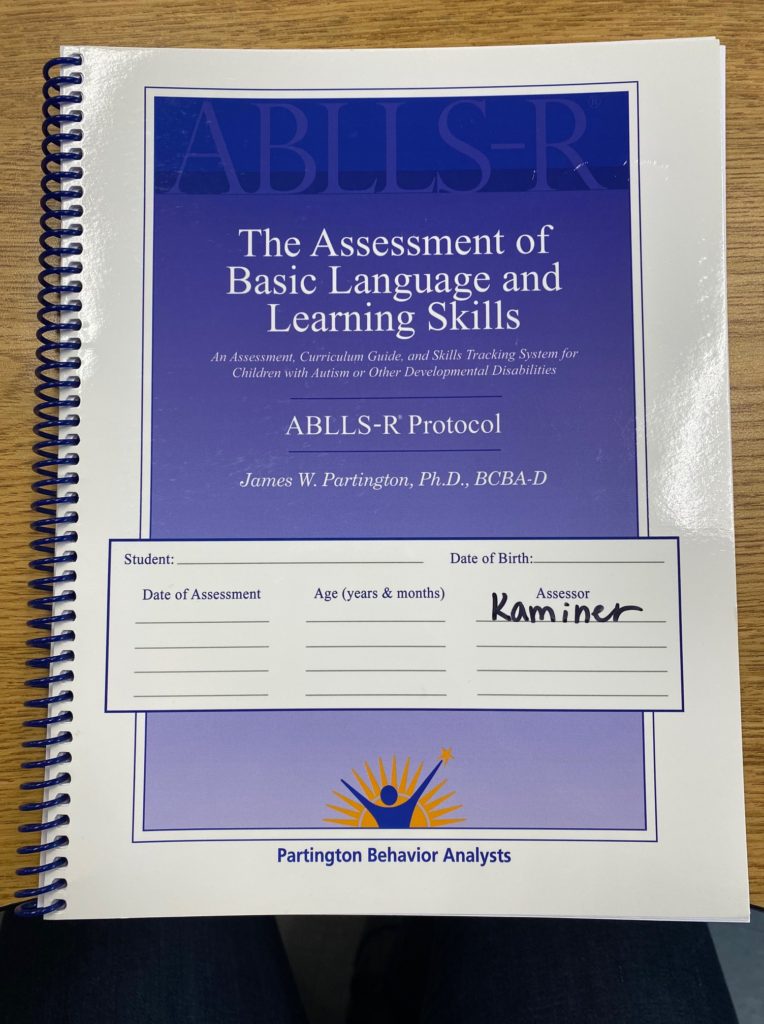
The Assessment of Basic Language and Learning Skills- Revised (ABLLS-R) is a criterion referenced assessment used to assess the strengths and deficits of children with language delays. It was originally written in 1998 by James Partington and Mark Sundberg. If that second name sounds familiar, that’s because he also wrote the Verbal Behavior Milestone Assessment and Placement Program (VB-MAPP).
Similar to the VB-MAPP, ABLLS-R breaks down the components of verbal behavior so that teachers, related service providers and parents can identify where a child’s current skills and create new educational targets. ABLLS-R is a longer assessment, with subsections from A to Z. In the protocol book, you will have the full protocol (including task name, task objective, target question, example responses and criteria for scoring) in addition to the tracking grids to help you score the assessment.
In this post, we are going to a deep dive into the ABLLS-R.

The Four Sub-Assessments That Make Up the ABLLS-R
Within the ABLLS-R, there are four sub-assessments in which a large variety of skills are assessed.
Basic Learner Skills Assessment includes:
A. Cooperation and Reinforcer Effectiveness
B. Visual Performance
C. Receptive Language
D. Imitation
E. Vocal Imitation
F. Requests (Mands)
G. Labeling (Tacting)
H. Intraverbals
I. Spontaneous Vocalizations
J. Syntax and Grammar
K. Play and Leisure
L. Social Interaction
M. Group Instruction
N. Follow Classroom Routines
P. Generalized Responding
Academic Skills Assessment
Q. Reading Skills
R. Math Skills
S. Writing Skills
T. Spelling
Self-Help Skills Assessment
U. Dressing Skills
V. Eating Skills
W. Grooming
X. Toileting Skills
Motor Skills Assessment
Y. Gross Motor Skills
Z. Fine Motor Skills

Setting Up the ABLLS-R
The ABLLS-R is an extremely extensive and thorough assessment. While this means that you will get a lot of data about your student’s abilities, it does take a lot of time to run and prepare.
The first thing I recommend doing is finding an ABLSS-R Kit. I use this one from The Autism Helper on Teachers Pay Teachers. There are also a lot of great Boom Card Decks that align to each of the subsections. When you search, you will see that there will be a letter and number that correspond with each deck. The letter corresponds to the subsection and the number is the question it goes along with.


Before beginning to run the assessment, I would photocopy the protocol and grid (so it can be used forever!) and prepare my stimuli. I like to look through the protocol so that I can be reminded on the section that I am going to run that day. I also like to remind myself of the examples and non-examples of correct responses. There are some sections that require observation, so I recommend figuring out the time and place that you will be able to observe your student interact with things in their environment.

Stimuli Examples
Helpful Hints
While every experience administering the ABLLS-R is going to be unique to the student you are assessing, these are some of my “must-dos” each time I run this assessment.
- Prep your protocol ahead of time: Like I said earlier, I like to photocopy the protocol book so that I can use it over and over again. This does take some time, so I like to make one copy as a master and then run it through the copier each time I need to administer this assessment.
- Observe/Complete sections ahead of time: If you are a classroom teacher looking to administer this assessment, you know your students and their abilities. Fill out what you can ahead of time so that you do not have to worry about having them wait for you as you fill it out.
- Skip around: This assessment does NOT have to be done in order in order to be done with fidelity. Each problem is assessed individually so if you don’t want to go in order, no need to worry! Skip around to make it easier or more accessible for your students.
- Understand the prompt hierarchy/prompt fading: If you are unfamiliar with the prompt hierarchy, review my post on it here! In order to get the most accurate scores for your student’s abilities, make sure you are allowing them to complete these tasks with the LEAST INVASIVE prompt level (ideally, this would be independent).
- Utilize schedules of reinforcement: This is more than likely going to be a low interest activity… be sure to provide adequate reinforcement to keep your students engaged!
Do you run the ABLLS-R with your students? Do you want to try it?
Let me know in the comments!








Where can I purchase this assessment? I don’t currently have an assessment to use with my students.
Hello Lisa! You can purchase the ABLLS-R at the following link: https://partingtonbehavioranalysts.com/products/ablls-r-the-assessment-of-basic-language-and-learning-skills-revised
I recommend the protocol and scoring guide bundle so you can read up on how to score the assessment.